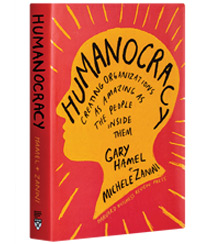If there was ever a year for strategy to do its job well, it’s 2020. The COVID-19 pandemic has forced many leaders to reconsider their strategies. They are refreshing or reimagining what they are there to do, for whom, how to best do it — and, in a world of great uncertainty, volatility, and fragility, they are asking themselves to what end. Many, during the crisis, will look on in awe at the success of platform companies that are powered by artificial intelligence (AI) — Amazon, Google, and Alibaba — and wonder how they can break through their own inertia.
Each of this year’s best business books on strategy offers a passionate and persuasive articulation of how strategy should be developed and executed in this context. These demanding reads dig deep into the intricacies of the issues and challenge the reader to act differently. In Uncharted, entrepreneur and author Margaret Heffernan sets out a compelling case for why and how we should think differently about the future. In the best among the books, Humanocracy, management thinkers Gary Hamel and Michele Zanini articulate a vivid manifesto and provide a prescriptive manual to bust bureaucracy in order to release the power of people in organizations. And in Competing in the Age of AI, Harvard professors Marco Iansiti and Karim R. Lakhani argue persuasively why, and how, companies should put AI at the center of what they do.
Rethinking our future
The timing of Uncharted: How to Navigate the Future could not have been any better. Heffernan argues that we have “come to expect the future to be minutely and perfectly predictable.” We are seduced by the outcome of an algorithm or the prediction of a confident economist, work that is often “ideological and self-interested.” However, we then think less, become more anxious, and lose some of our creativity and imagination. We become passive and gullible, relying on simplifications or false determinism. And we face some tough ethical questions — especially when technology promises to help us maximize the lifelong potential of our children, change our genes, or extend our life span.
The central premise of the book is that we must get comfortable with uncertainty and ambiguity about the future, especially when facing complexity. And we need to be prepared to experiment, explore, and question; we should resist the temptation to use the typical “forecast, plan, execute” approach developed by efficiency aficionados looking to eliminate uncertainty.
Encouraging participation in the process is critical, and it should be anchored by a clear recognition that the status quo doesn’t work. At the Dell Medical School at the University of Texas, patients were put in charge of their destiny, with doctors acting as guides, which resulted in a 19 percent increase in patient adherence to therapies and improved outcomes. In Northern Ireland, citizen assemblies were structured to debate the sensitive topic of abortion, which ultimately led to an outcome that mirrored the vote of the assembly. In Mexico, criminals, religious figures, and indigenous farmers, among others, came together to develop scenarios for their country in 2030.
Elsewhere, the quest for a drug to allow AIDS sufferers to lead a normal life brought together activists, scientists, bureaucrats, radicals, the healthy, and the sick, bound by a passionate faith in a better future. Contrary to what some textbooks might tell you, success didn’t come down to “one thing. No one action. No one plan. No one organization. No one leader. Not even one drug. It had taken everything and everyone.” Two aspects were critical: shaming (to get the attention of the medical establishment), and expertise (to maintain their attention).
When it comes to strategy, Heffernan asks: “Have decades of strategic planning left companies paralyzed, unable to explore without a map, incontrovertible data, rock-solid guarantees?” Maybe. But the book outlines a clear set of actions leaders can take to overcome this challenge. Avoid relying too heavily on analogies or historical precedents without careful interrogation and translation. Question the assumptions and limitations of models, and debate the implications. Become more curious about what’s happening — look for gaps, anomalies, and paradoxes through careful scanning and collecting of information. Avoid latching on to predetermined views of the future. Use scenarios to “capture ways of seeing the future that are recognizable to everyone.”
When leaders are coalescing groups of people who are diverse in their expertise and backgrounds to explore new solutions, they should play the role of diplomats and translators. And they must get more comfortable with a messy process; after all, some of the finest discoveries in arts, counterintelligence, and science came from people “wandering,” keeping an open mind for new ideas and insights. Even if the process comes across as a little wasteful, clarity will emerge at some point.
Heffernan’s is a very thoughtful, well-researched, encyclopedic management book, written at times in the style of a novel. The breadth and depth of its stories is remarkable, covering the arts, science, the environment, epidemics, healthcare, relationships, counterterrorism, military conflict, and business.
Ultimately, Heffernan is optimistic about the power of our minds and spirits to shape better futures for ourselves and the coming generations. But to do so will require leaders to have a backbone — to care — and to have the courage to experiment, not rely slavishly on lessons from the past or promises for the future.
Busting bureaucracy
In complex environments, Heffernan argues that a focus on efficiency is a hazard, not a help. Gary Hamel and Michele Zanini pick up on this theme in Humanocracy: Creating Organizations as Amazing as the People Inside Them. Bureaucracy, characterized by “authoritarian power structures, suffocating rules, and toxic politicking,” is in rude health, especially in large organizations. Alas, the attributes that define bureaucracy — discipline, reliability, conformity, and efficiency — are hardly what is required to create more purpose-driven organizations. Bureaucracies are better for “exploiting” than “exploring” activities. After all, the authors write, “deep change in a bureaucracy is usually belated and convulsive. Bureaucracies are also innovation-phobic…congenitally risk averse, and offer few incentives to those inclined to challenge the status quo.”
Hamel and Zanini want to replace bureaucracy with something far better: humanocracy, a concept based on maximizing the contribution, rather than the compliance, of humans. The economic spoils are significant — the authors estimate a US$10 trillion productivity dividend across the Organisation for Economic Co-operation and Development countries over 10 years. Also significant is the moral imperative: There are substantial benefits to employees, many of whom leave their true selves at home given how disengaged and dulled they are at work.
How can leaders give humans primacy over structures? After undergoing a bureaucracy “detox,” the authors say, leaders need to give power away, slim down management layers, introduce market-based mechanisms to allocate resources, give their people more information, set up lots of experiments to test new ideas, and then find and nurture the “hacktivists” in their organizations — those who can inspire and deliver change. The agenda Hamel and Zanini lay out is certainly demanding. Leaders have to be radical in their ambition, and pragmatic in the transition, given how entrenched bureaucracy is. Strategy has to take on a different role, too. The authors advocate a strategy process that is open to customers, employees, and external partners so it can generate more radical and ambitious ideas, and encourage more commitment to delivering it.
Hamel and Zanini argue convincingly that bureaucracy doesn’t have to go hand in hand with growth: “You can build organizations that are big and fast, disciplined and empowering, efficient and entrepreneurial, and bold and prudent.” Indeed, large companies are well equipped to encourage entrepreneurship if they tap into their comparative advantages: capital, employee base, customer data, and powerful brands.
Large companies are well equipped to encourage entrepreneurship if they tap into their comparative advantages: capital, employee base, customer data, and powerful brands.
The new pioneers are doing just this, and delivering strong performances. Even undertakings as complex as CERN’s ATLAS Project (a giant particle detector) can deliver on time and on budget without bureaucracy. Its systems are not free-for-alls; they’re anchored in transparency and accountability. In the case of global appliance maker Haier, a leadership election is called if a microenterprise misses its targets for three months.
Training also plays a crucial role in building new capabilities and developing new mindsets. Buurtzorg, a Dutch healthcare organization, trains every employee in group decision-making, active listening, and conflict resolution, all with the aim of greater empowerment; this organization of 15,000 people is led by two directors and 100 administrative personnel.
The case study of an innovative steelmaking company is particularly compelling in showing how humanocracy can work. The corporate center is minuscule, setting strategy, reviewing major capital requests, and establishing a few basic rules and minimum performance standards. The leadership encourages reverse accountability (i.e., team members are directly involved in the selection of supervisors and managers), “ridiculous” amounts of empowerment among frontline employees, strong learning networks, regular customer interaction, and better interviewing of new hires (focusing on testing the candidates’ resourcefulness and self-management).
Humanocracy is an…





